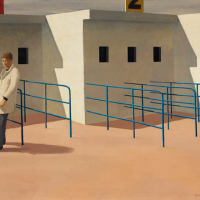71. JEFFREY SMART

There is a peculiar melancholy about an empty space designed to accommodate a crowd. Anybody who has ever visited a resort town out of season can testify to the sense of desolation one feels in such places, in which shops, restaurants and hotels are geared to the needs of tourists and pleasure-seekers. The brazen trappings of the leisure industry, the promises of mass entertainment and spectacle, take on a dull pathos when there is nobody to buy whats being advertised.
Throughout his long career, Jeffrey Smart was consistently attracted to those places most artists would avoid. A glorious landscape was never his idea of a worthwhile subject. Instead, he set out to paint those non-places, as the French anthropologist, Marc Aug has termed them1 sites such as airport terminals, hotel rooms, motorways, and shopping malls, through which people pass without forming a group identity.
He is not the first artist to focus on these zones of transience. Edward Hopper is probably the worlds most famous painter of hotel rooms and empty foyers, but non-places are so characteristic of urban modernism they make fleeting appearances in the work of almost every artist who adopted the city as a theme. For Smart they were core motifs, affording him a distinctively modern subject, to be painted in a style that announced its continuity with the artistic traditions of the Renaissance.
Ticket Boxes, Catania depicts a classic non-place: the ticket booth of a large public auditorium. Because Smart has identified the setting as Catania in Sicily, its a fair guess were looking at the Cibali Stadium, which was designed by architect, Raffaele Leone, and opened during the Mussolini era, in 1935. The stadium was renamed Stadio Angelo Massimino in 2002, after a long-serving chairman of the Catania football club. Does this information help us understand the painting? Not really, although it serves as a reminder that Smart always worked from actual places he had seen and sketched, even if he reserved the right to alter and recombine features to suit his compositional requirements.
Smart also used real people as models for the figures in his paintings, and the man in Ticket Boxes, Catania is the Australian artist, Keith Looby (born 1940), who was 24 years old at the time, at the half-way point of a seven-year stay in Italy. Smart was a mentor to the young Looby, who would hold his first solo exhibition in 1964, at the Carpini Gallery in Rome.
Smarts archivist, Stephen Rogers, writes that Ticket Boxes, Catania would be included in Smarts own first show in Rome, at Galleria 88, in April 1965.2 The painting failed to sell but would be included in a September 1965 exhibition at Sydneys Macquarie Galleries, where it found a buyer.
Smart depicts Looby leaning against one of the thin blue barriers that direct queues to each ticket box. He might be a disappointed fan who has missed the match or arrived too late to get a ticket. Whenever we encounter a single figure in a space specifically designed for a crowd, theres an inevitable impression of loneliness or alienation. Although he was reluctant to interfere with the way his paintings were interpreted, Smart would always disavow the idea he was portraying an existential predicament. If Man-is-alone-in-a godless-universe, that was never his concern.
Smarts standard explanation, that the figures were simply there for scale, is only one part of the story. Whether it was a conscious strategy or not, the lone figures in so many of his paintings act as mirrors of that singular act of contemplation the artist expected from the viewer. He would have liked us to spend time with the work and recognise that images such as Ticket Boxes, Catania are not as straightforward as they may seem at first glance. Smart was a lifelong devotee of the classical formula known as the golden ratio, which can imbue even the simplest pictures with a feeling of rightness. He would also use repetition and number games to draw us into a work.
Ticket Boxes, Catania is rigorous in its geometrical underpinnings, being divided into three distinct horizontal bands, three identical modules trimmed by the sides of the canvas. From left to right the first ticket box has two square windows, the middle has three, the third has one. The clipped-off numbers on top of the booths contradict the allotment of windows, with the number three sitting atop the two-window box and vice versa. The blue metal rails repeat themselves in formation.
There could hardly be a more blatant non-place than a ticket box in front of a deserted stadium, but Smart invites us to linger, studying the precise arrangement of the boxes, rails and windows; wondering what the man in the white coat might be doing.
In the precision of his compositions and the sense of mystery his images generate, Smart took the most unremarkable locations and imbued them with a sense of order, and even beauty. It is perhaps, the most striking achievement of his work that he has been able to take those spaces we pass through every day without giving them the slightest thought and invest them with an extraordinary pictorial presence. As Marc Aug notes, a space is only a non-place to those to move quickly through it, not to those who work or spend time there. By getting us to pause and look through fresh eyes, Smart asks us to imaginatively inhabit these places, making sure they leave an indelible impression on our minds.
Footnotes:
1. Aug, M., Non-Places: An Introduction to Super-Modernity, Verso, London, 2009
2. Stephen Rogers in email correspondence with the author, 26 September 2022
John McDonald
John McDonald is the author of Jeffrey Smart: Paintings of the 70s and 80s. He writes a weekly art column for the Sydney Morning Herald and a weekly film column for the Australian Financial Review.